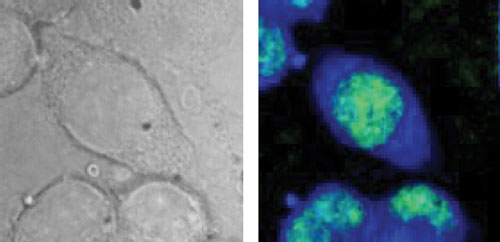 With improved hardware and better signal processing, a powerful form of molecular vibration spectroscopy can quickly deliver detailed molecular maps of the contents of cells without damaging them. Earlier studies have suggested that to be useful, the technique would need power levels too high for cells.
With improved hardware and better signal processing, a powerful form of molecular vibration spectroscopy can quickly deliver detailed molecular maps of the contents of cells without damaging them. Earlier studies have suggested that to be useful, the technique would need power levels too high for cells.
Oct 14th, 2010
Read more
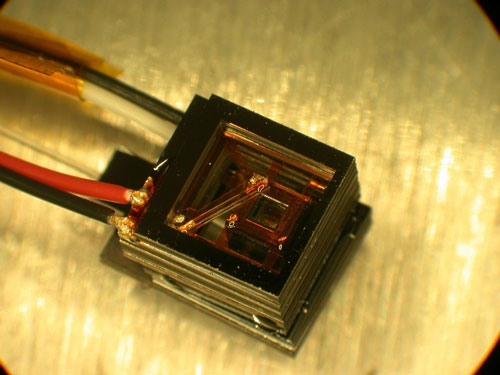 Researchers from the National Institute of Standards and Technology (NIST) and the German national metrology institute have used NIST's miniature atom-based magnetic sensor to successfully track a human heartbeat, confirming the device's potential for biomedical applications.
Researchers from the National Institute of Standards and Technology (NIST) and the German national metrology institute have used NIST's miniature atom-based magnetic sensor to successfully track a human heartbeat, confirming the device's potential for biomedical applications.
Oct 14th, 2010
Read more
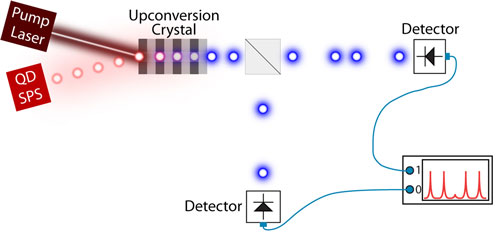 Researchers at the National Institute of Standards and Technology (NIST) have demonstrated for the first time the conversion of near-infrared 1,300 nm wavelength single photons emitted from a true quantum source, a semiconductor quantum dot, to a near-visible wavelength of 710 nm.
Researchers at the National Institute of Standards and Technology (NIST) have demonstrated for the first time the conversion of near-infrared 1,300 nm wavelength single photons emitted from a true quantum source, a semiconductor quantum dot, to a near-visible wavelength of 710 nm.
Oct 14th, 2010
Read more
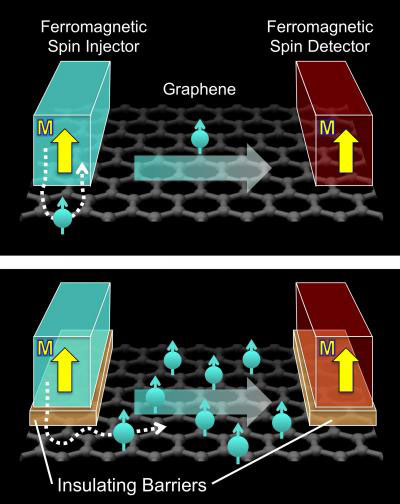 Roland Kawakami's lab at UC Riverside is first to achieve 'tunneling spin injection' into graphene.
Roland Kawakami's lab at UC Riverside is first to achieve 'tunneling spin injection' into graphene.
Oct 14th, 2010
Read more
Scientists at the University of Leeds have perfected a new technique that allows them to make molecular nanowires out of thin strips of ring-shaped molecules known as discotic liquid crystals (DLCs).
Oct 14th, 2010
Read more
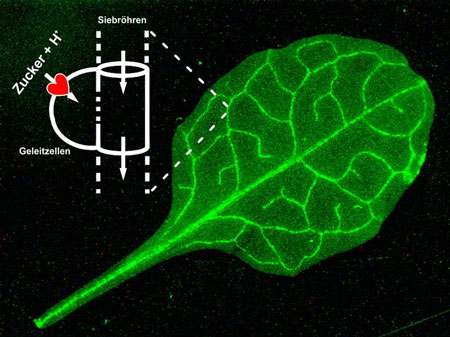 Als Produzenten von Zucker und Kohlenhydraten spielen Pflanzen eine wichtige Rolle. Auf diesem Gebiet forschen Wissenschaftler der Uni Wuerzburg - mit dem Fernziel, den Zuckerhaushalt landwirtschaftlicher Nutzpflanzen zu beeinflussen.
Als Produzenten von Zucker und Kohlenhydraten spielen Pflanzen eine wichtige Rolle. Auf diesem Gebiet forschen Wissenschaftler der Uni Wuerzburg - mit dem Fernziel, den Zuckerhaushalt landwirtschaftlicher Nutzpflanzen zu beeinflussen.
Oct 14th, 2010
Read more
The California Institute of Technology (Caltech) and CEA-Leti, co-founders of the NanoVLSI Alliance, have launched the NanoSystems Partnership Program (NSyP) to accelerate delivery of nanosystems-based innovations to the market.
Oct 14th, 2010
Read more
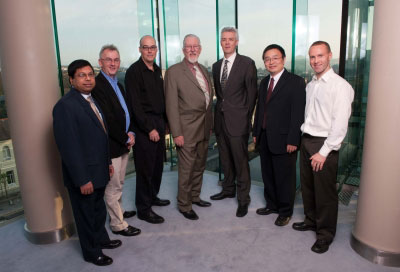 Tyndall National Institute, UCC announced today, Wednesday, at the 2010 International Power Supply on Chip Workshop in Cork, the development of a new nano-material that will dramatically reduce the operating temperature of silicon chip components and circuits, thereby enhancing the reliability and lifetime of electronics in products ranging from smart phones to automotive electronics.
Tyndall National Institute, UCC announced today, Wednesday, at the 2010 International Power Supply on Chip Workshop in Cork, the development of a new nano-material that will dramatically reduce the operating temperature of silicon chip components and circuits, thereby enhancing the reliability and lifetime of electronics in products ranging from smart phones to automotive electronics.
Oct 14th, 2010
Read more
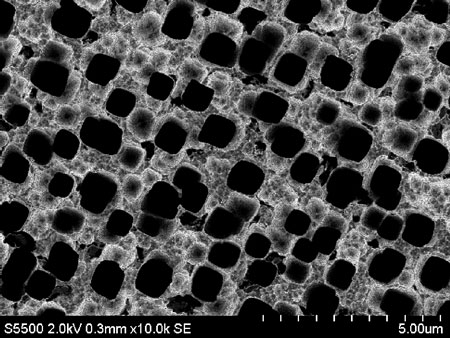 Rice researchers advance lithium-ion technique for electric cars, large-capacity storage.
Rice researchers advance lithium-ion technique for electric cars, large-capacity storage.
Oct 13th, 2010
Read more
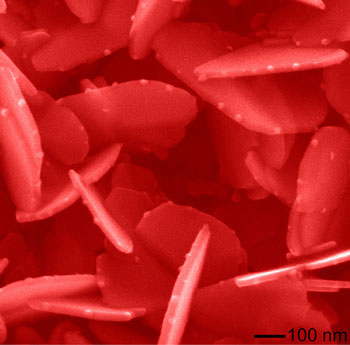 A team of scientists at the U.S. Department of Energy's (DOE) Argonne National Laboratory and the Carnegie Institution of Washington has succeeded in 'watching' nanoparticles grow in real time
A team of scientists at the U.S. Department of Energy's (DOE) Argonne National Laboratory and the Carnegie Institution of Washington has succeeded in 'watching' nanoparticles grow in real time
Oct 13th, 2010
Read more
Unless you are in a field of study related to cell biology, you most likely have never heard of Ndc80. Yet this protein complex is essential to mitosis, the process by which a living cell separates its chromosomes and distributes them equally between its two daughter cells. Now, through a combination of cryo-electron microscopy and three-dimensional image reconstruction, a team of researchers have produced a subnanometer resolution model of human Ndc80 that reveals how this unsung hero carries out its essential tasks.
Oct 13th, 2010
Read more
Participants at the recent 7th Annual International Symposium on Advanced Gate Stack Technology discussed strategies for implementing advanced logic and memory technologies for sub-16 nm node and beyond process technologies.
Oct 13th, 2010
Read more
Rice University research that capitalizes on the wide-ranging capabilities of graphene could lead to circuit applications that are far more compact and versatile than what is now feasible with silicon-based technologies.
Oct 13th, 2010
Read more
Scientists working in Germany and Switzerland have developed a novel nano-tomography method, which uses X-rays to allow doctors to produce three-dimensional (3D) detailed imaging of fragile bone structures. This method could lead to the development of better therapeutic approaches to tackle the brittle bone disease osteoporosis, one of the most common disorders among older people.
Oct 13th, 2010
Read more
CEA-Leti will highlight its programs and recent developments in lithography, FDSOI and 3D design and integration at SEMICON Europa, Oct. 19-21 in Dresden, Germany.
Oct 13th, 2010
Read more
With almost one billion people lacking access to clean, safe drinking water, scientists are reporting development and successful initial tests of an inexpensive new filtering technology that kills up to 98 percent of disease-causing bacteria in water in seconds without clogging.
Oct 13th, 2010
Read more
 With improved hardware and better signal processing, a powerful form of molecular vibration spectroscopy can quickly deliver detailed molecular maps of the contents of cells without damaging them. Earlier studies have suggested that to be useful, the technique would need power levels too high for cells.
With improved hardware and better signal processing, a powerful form of molecular vibration spectroscopy can quickly deliver detailed molecular maps of the contents of cells without damaging them. Earlier studies have suggested that to be useful, the technique would need power levels too high for cells. 







 Subscribe to our Nanotechnology News feed
Subscribe to our Nanotechnology News feed